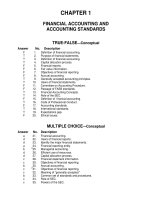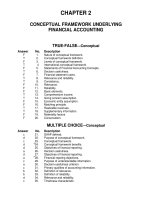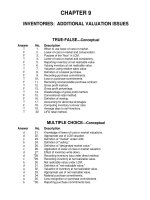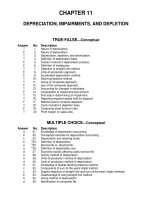Intermediate accounting 16e by kieso slide ch07
Bạn đang xem bản rút gọn của tài liệu. Xem và tải ngay bản đầy đủ của tài liệu tại đây (3.57 MB, 127 trang )
7-1
PREVIEW OF CHAPTER 7
Intermediate Accounting
16th Edition
Kieso ● Weygandt ● Warfield
7-2
7
Cash and Receivables
LEARNING
LEARNINGOBJECTIVES
OBJECTIVES
After studying this chapter, you should be able to:
1
Indicate how to report cash and related items.
2
Define receivables and understand accounting issues
3
4
valuation of notes receivable.
related to their recognition.
5
Explain the fair value option.
Explain accounting issues related to valuation of
6
Explain accounting issues related to disposition of
accounts and notes receivable.
accounts receivable.
7
7-3
Explain accounting issues related to recognition and
Describe how to report and analyze receivables.
LO 1
CASH
CASH
What is Cash?
Most liquid asset.
Standard medium of exchange.
Basis for measuring and accounting for all items.
Current asset.
Examples: coin, currency, available funds on deposit at the bank, money orders, certified checks,
cashier’s checks, personal checks, bank drafts and savings accounts.
7-4
LO 1
CASH
CASH
Reporting Cash
Cash Equivalents
Short-term, highly liquid investments that are both
a)
readily convertible to cash, and
b)
so near their maturity that they present insignificant risk of changes in value.
Examples: Treasury bills, Commercial paper, and Money market funds.
7-5
LO 1
Reporting
ReportingCash
Cash
Restricted Cash
Companies segregate restricted cash from “regular” cash.
Examples, restricted for:
(1) plant expansion, (2) retirement of long-term debt, and
(3) compensating balances.
ILLUSTRATION 7-1
Disclosure of Restricted Cash
7-6
LO 1
Reporting
ReportingCash
Cash
Bank Overdrafts
Company writes a check for more than the amount in its cash account.
7-7
Generally reported as a current liability.
Offset against other cash accounts only when accounts are with the same bank.
LO 1
ILLUSTRATION 7-2
Classification of Cash-Related Items
7-8
LO 1
WHAT DO THE NUMBERS MEAN?
WHERE DID I PARK MY CASH?
WHAT’S YOUR PRINCIPLE
We have learned that companies report both cash and cash equivalents as cash on
their balance sheets. But where do they park cash that is not used to pay for inventory,
employees, or other expenses? As shown in the chart to the right, companies plow the
largest portion of their cash holdings into corporate debt. As indicated, corporate debt is
the parking place of choice, followed by U.S. Treasury and agency debt. Surveyed
corporate treasurers say that high-grade corporate bonds are preferred because they
are reasonably safe while providing a greater yield premium relative to Treasurys.
Seems like a good strategy as long as the corporate issuers can make their payments.
However, if the economy takes a downturn, similar to investments in auction-rate notes,
these investments may not be true cash equivalents.
Source: J. Willhite, “Companies Park Cash in Corporate Debt,” Wall Street Journal (December 4, 2012).
7-9
LO 1
7
Cash and Receivables
LEARNING
LEARNINGOBJECTIVES
OBJECTIVES
After studying this chapter, you should be able to:
1
Indicate how to report cash and related items.
2
Define receivables and understand accounting
3
4
valuation of notes receivable.
issues related to their recognition.
5
Explain the fair value option.
Explain accounting issues related to valuation of
6
Explain accounting issues related to disposition of
accounts and notes receivable.
accounts receivable.
7
7-10
Explain accounting issues related to recognition and
Describe how to report and analyze receivables.
LO 2
RECEIVABLES
RECEIVABLES
Receivables - Claims held against customers and others for money, goods, or services.
Oral promises of the purchaser to pay for goods
Written promises to pay a sum of money on a
and services sold.
Accounts
AccountsReceivable
Receivable
specified future date.
Notes
Notes
Receivable
Receivable
7-11
LO 2
RECEIVABLES
RECEIVABLES
Nontrade Receivables
1.
Advances to officers and employees.
2.
Advances to subsidiaries.
3.
Deposits paid to cover potential damages or losses.
4.
Deposits paid as a guarantee of performance or payment.
5.
Dividends and interest receivable.
6.
Claims against: Insurance companies for casualties sustained; defendants under suit; governmental bodies for
tax refunds; common carriers for damaged or lost goods; creditors for returned, damaged, or lost goods;
customers for returnable items (crates, containers, etc.).
7-12
LO 2
RECEIVABLES
Nontrade Receivables
ILLUSTRATION 7-3
Receivables Balance
Sheet Presentations
7-13
LO 2
Recognition
Recognitionof
ofAccounts
AccountsReceivables
Receivables
Accounts receivable generally arise as part of a revenue arrangement.
The revenue recognition principle indicates that a company should recognize revenue
when it satisfies its performance obligation by transferring the good or service to the
customer.
7-14
LO 2
Recognition
Recognitionof
ofAccounts
AccountsReceivables
Receivables
For example, if Lululemon sells a yoga outfit to Jennifer Burian for $100 on account, the yoga outfit is
transferred when Jennifer obtains control of this outfit. When this change in control occurs, Lululemon
should recognize an account receivable and sales revenue. Lululemon makes the following entry:
Accounts Receivable
Sales Revenue
7-15
100
100
LO 2
Recognition
Recognitionof
ofAccounts
AccountsReceivables
Receivables
Some key indicators that Lululemon has transferred and that Jennifer has obtained control of the yoga
outfit.
7-16
1.
Lululemon has the right to payment from the customer.
2.
Lululemon has passed legal title to the customer.
3.
Lululemon has transferred physical possession of the goods.
4.
Lululemon no longer has significant risks and rewards of ownership of the goods.
5.
Jennifer has accepted the asset.
LO 2
Recognition
Recognitionof
ofAccounts
AccountsReceivables
Receivables
Measurement of the Transaction Price
The transaction price is the amount of consideration that a company expects to receive from a customer
in exchange for transferring goods or services.
Variable Consideration
In some cases the price of a good or service is dependent on future events. These future events often
include such items as discounts, returns and allowances, rebates, and performance bonuses.
7-17
LO 2
Recognition
Recognitionof
ofAccounts
AccountsReceivables
Receivables
Trade Discounts
Reductions from the list price.
Not recognized in the accounting records.
10 % Discount for
new Retail Store
7-18
Customers are billed net of discounts.
Customers
LO 2
Recognition
Recognitionof
ofAccounts
AccountsReceivables
Receivables
Cash Discounts (Sales Discounts)
Offered to induce prompt payment.
Presented in terms such as
2/10, n/30
2/10, E.O.M.,
Payment terms are
2/10, n/30
7-19
net 30, E.O.M.
Gross Method vs. Net Method.
LO 2
Cash
CashDiscounts
Discounts(Sales
(SalesDiscounts)
Discounts)
ILLUSTRATION 7-4
Entries under Gross and Net Methods of Recording Cash (Sales) Discounts
7-20
LO 2
Cash Discounts (Sales Discounts)
Illustration: On June 3, Bolton Company sold to Arquette Company merchandise having a sale price of $2,000 with
terms of 2/10, n/60, f.o.b. shipping point. On June 12, the company received a check for the balance due from Arquette
Company. Prepare the journal entries on Bolton Company books to record the sale assuming Bolton records sales
using the gross method.
June 3
Accounts Receivable
2,000
Sales
June 12
Cash ($2,000
2,000 x 98%)
Sales Discounts
Accounts Receivable
7-21
1,960
40
2,000
LO 2
Cash Discounts (Sales Discounts)
Illustration: On June 3, Bolton Company sold to Arquette Company merchandise having a sale price of $2,000 with
terms of 2/10, n/60, f.o.b. shipping point. On June 12, the company received a check for the balance due from Arquette
Company. Prepare the journal entries on Bolton Company books to record the sale assuming Bolton records sales
using the net method.
June 3
Accounts Receivable
1,960
Sales
June 12
Cash ($2,000
1,960 x 98%)
Accounts Receivable
7-22
1,960
1,960
LO 2
Cash Discounts (Sales Discounts)
Illustration: On June 3, Bolton Company sold to Arquette Company merchandise having a sale price of $2,000 with
terms of 2/10, n/60, f.o.b. shipping point. Prepare the journal entries on Bolton Company books to record the sale
assuming Bolton records sales using the net method, and Arquette did not remit payment until July 29.
June 3
Accounts Receivable
1,960
Sales
June 29
Cash 2,000
1,960
Accounts Receivable
Sales Discounts Forfeited
7-23
1,960
40
LO 2
Recognition
Recognitionof
ofAccounts
AccountsReceivables
Receivables
Sales Returns and Allowances
Sales Returns and Allowances is a contra revenue account to Sales Revenue.
Allowance for Sales Returns and Allowances is a contra asset account to Accounts Receivable.
The use of both Sales Returns and Allowances, and Allowance for Sales Return and Allowances
accounts is helpful to identify potential problems associated with inferior merchandise,
inefficiencies in filling orders, or delivery or shipment mistakes.
7-24
LO 2
Sales
SalesReturns
Returnsand
andAllowances
Allowances
Illustration: Assume that Max Glass sells $5,000 of hurricane glass to Oliver Builders on account. Max Glass
estimates that $400 of these glass sales will either be returned or an allowance will be granted. Max Glass records
the sale on account and records an allowance for sales returns and allowances as follows.
Accounts Receivable
5,000
Sales Revenue
Sales Returns and Allowances
5,000
400
Allowance for Sales Returns and Allowances
7-25
400
LO 2









